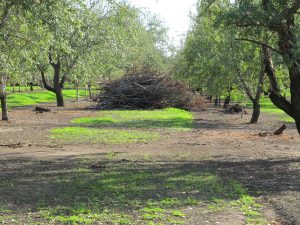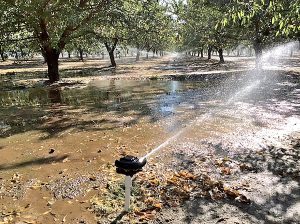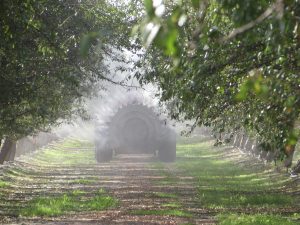
Director, Member Relations
This is the final report of the 2016 crop year, covering the conditions and observations made between Monday, October 3, and Sunday, October 23, 2016. The next report will be posted on or about Monday, January 30, 2017 prior to the start of the 2017 bloom.
North – Sacramento Valley growers enjoyed generally mild conditions for much of the period, with ample time to complete the 2016 harvest. Daily maximum temperatures were reported at their lowest values in the low 60’s early in the period, with the highest values coming just one week later when readings reached into the upper 80’s to lower 90s. Temperatures moderated for the balance of the period, varying between the upper 60’s and lower 80’s, even as the first storm of the season dropped from 0.5 to 1.0 inch of rainfall throughout the region. Morning lows exhibited a bit more stability, with readings reported predominately between the mid 40’s and mid 50’s throughout the period.
Harvest operations have been completed in the Sacramento Valley. Weather conditions throughout the harvest season provided growers with ample opportunity to bring in their crops this year, with rainfall holding off until all but the last of the late maturing varieties were removed from the orchards. As may be seen in the accompanying photos, growers are pruning and removing trees or entire orchards, in addition to fertilizing and completing post-harvest irrigations. While the harvest has just been completed, some post-harvest tasks are designed to aid the next crop and it’s harvest ten months from now. Smoothing orchard floors and applications of herbicides are both designed to facilitate the next harvest. While growers work within existing orchards, they have also been putting the finishing touches on lands being planted to new orchards. Irrigations systems have been installed and the land prepared to receive new trees during the winter dormant period.
Huller/sheller operations are also winding down. Larger operations with the greatest amount of stockpiled product are expecting to finish their work by the end of November.
Central – While October brought the first rainfall of the season to the northern San Joaquin Valley, weather conditions during the period provided ample opportunities to complete the 2016 harvest. Daily maximum temperatures dipped into the mid 60’s in the period’s opening days, then climbed to their peak values in the upper 80’s and lower 90’s by the 9th and 10th of the month. Readings then settled back into the 70’s and 80’s for the balance of the period, even as the first storm of the season delivered 0.1 to 1.0 inch of rain between the 14th and 16th of the month. Morning lows were widely reported between the mid 40’s and mid 50’s during the period. except during the storm’s passage when reading reached into the upper 60’s, reflecting the warm nature of the storm.
Very favorable weather during the period’s first weeks allowed growers to complete the northern San Joaquin Valley’s fastest harvest in anyone’s memory. At this point, only a few late maturing Fritz plantings remain to be picked up and we are now pronouncing harvest operations to be complete. Rain that fell over the region failed to hinder the harvest. Growers with the latest maturing Fritz plantings largely left the crop in the trees, opting to shake after the rain had passed. These growers are now working to bring the crop in, most of which will require some degree of drying in order to be safely stored.
Post-harvest tasks now dominate grower’s activities. Critical post-harvest irrigations have been completed, though at least one irrigation district has opted to make water available through October, allowing growers to ensure their orchards have adequate soil moisture. Pruning and fertilizer applications, via soil and foliar methods are being conducted, as are applications of soil amendments such as gypsum designed to improve water penetration. Also, as shown in the accompanying photo, older, lower producing orchards are being removed and the lands prepared for replanting.
Huller/sheller operators are now focused on previously stockpiled product and are working complete their operations by the first of December.
South – Mild to warm conditions dominated the southern region’s weather during October, providing ample opportunities for completion of the 2016 harvest. Daily maximum temperatures ranged between the lower 70’s and lower 90’s, with warmest readings reported at the end of the period’s first week. Meanwhile, morning low temperatures dipped into the mid 40’s to lower 50’s throughout the month. Rainfall threatened to dampen the final days of harvest as a fairly potent early-season weather system approached at mid-month. While the system brought the hope of rainfall, promises were broken and only a few hundredths of an inch of rain was reported in the isolated area of the region.
While a few, isolated orchards remain to be picked up, we can now pronounce that harvest operations have been completed in the southern region. This year’s harvest was one of the smoothest, trouble-free seasons in memory. Growers have moved on to post-harvest operations, first of all completing critical irrigations needed to replenish the soil profile. Observers have reported that a large number of orchards are receiving applications of gypsum, calcium sulfate, needed to “open” the soil, providing a means to exchanged sodium accumulations, improving water penetration and overall tree health. Fertilizer applications are also being conducted; potassium and compost via soil applications and zinc sulfate through foliar treatments. Crews can be found pruning trees and shredders have already moved into the region to grind the resulting brush.
As shown in the accompanying photo, crews can also be found performing maintenance on the region’s many wells. All in the region are hopeful that this winter will bring ample rainfall. Rain is needed for many reasons. Replenish reservoirs, cleanse the soil, and provide for easier removal of nuts that failed to shake from the trees during the harvest are just but a few.
As growers work to complete required tasks, huller/sheller operators are working to complete processing previously harvested product. While most will be finishing their season in the next few weeks, larger operations with the greatest amount of stockpiled crop expect to finish the last loads of the year by the end of November.


